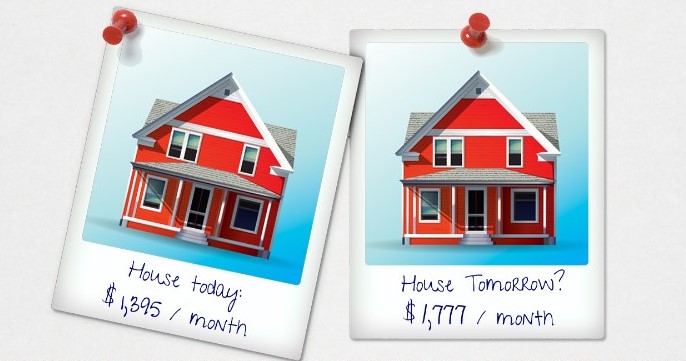The Potential Cost of Waiting

Affordability declines quickly when rates and prices rise together.
The potential change in payments with a 10% price increase and a 2% increase in interest rates:

These hypothetical examples are illustrations for educational purposes only are not an offer to lend. Examples are for a $250,000 with a rate increase from 4.50%/4.762% APR on a zero point 30-year, fixed rate loan with a 20% down payment, $4,000 in taxes and annual insurance of $580 for the “today” example and $638 for the “tomorrow” example. APRs are calculated using closing costs equal to 3% of the loan amount. Actual costs can be less, and actual rates are subject to change at any time. Qualification for any loan is dependent on individual circumstance and subject but not limited to employment/income, credit history and acceptable liquid assets to close.
First time home buyers currently have a historical advantage with both low rates and prices. What happens when the trend begins to shift?
You might not qualify to purchase the same house.
Unless your income keeps pace with price and/or rate increases, you may not be able to qualify for the same home you could purchase today. In the example above, the income to qualify increases from $4,038 per month to $5,127 (assuming a debt-to-income ratio of 35%). The 27% increase is much higher than the typical salary increase of about 2% or 3% per year.
In a rising market, you usually can’t out-save appreciation.
When prices are rising, it can be difficult for your savings to outpace the market. For example, if a $300,000 home appreciates by 5% in one year, that’s $15,000 or $1,250 per month. Can you add that amount to what you’re already saving each month? If interest rates are rising, too, required payments and income increase even more.
Given the recent environment, some may discount the possibility of the 2% increase in the example above, but the 50-year average for a 30-year, fixed-rate conventional loan is approximately 8.375%. That’s almost 4% higher than rates at the time of this writing and would equate to a payment increase of more than $663 per month in the example.
Qualified borrowers have the ability to lock in today’s prices and rates. Buyers who have not yet accumulated a large down payment may find that using a small down payment and paying mortgage insurance is wiser than missing out on low prices and historically low rates,
We’re here to help when you’re ready to learn more.






_0.png)

